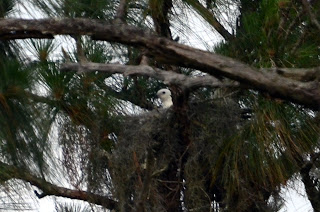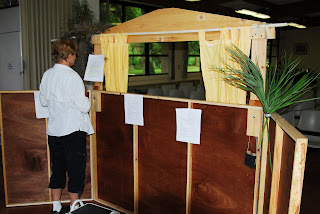20 April was our Swallow-tailed Kite Day in the park. Quite frankly, before coming to Florida this winter, I had never heard of a Kite, other than the type I flew on a string many years ago.
From Wiki: The Swallow-tailed Kite is an elanid kite which breeds from the Southeastern US to eastern Peru and northern Argentina. Most North and Central American breeders winter in South America where the species is resident year round. It was formerly named Falco forficatus. Swallow-tailed Kites inhabit mostly woodland and forested wetlands near nesting locations. Nests are built in trees, usually near water. Both male and female participate in building the nest. Sometimes a high-pitched chirp is emitted, though the birds mostly remain silent. Mating occurs from March to May, with the female laying 2 to 4 eggs. Incubation lasts 28 days, and 36 to 42 days to fledge.
We have five nesting pairs here in the park. Kristin Woods, Ranger-Coordinator, tells us that they have never so many birds here, so she is excited. Her official duties are as the Park Services Specialist (OPS), and she is always planning events for the park and surrounding communities.
Here is Kristin, in her element, giving instructions and information to a recent "Eggs in the Park" event. A Vermont native, her education and desire for warmer climes brought her to Florida over 20 years ago. She has been in the Dade Park for about two years. Her Masters degree is in Aviary (Birding) and I think a minor in lizards. She was really excited to see that the Kites had five nests in the Park. I in fact found two of them. They nest high up in the tall Longleaf Pine trees.
I snapped several hundred pics of the Kites, but few are saved as it takes many snaps to get a few decent ones. Thank goodness for digital photography.
A typical nest about 100 yards from where we are parked here in the Park. I was lucky enough to catch a Kite in flight over this nest. These pics were a couple of weeks ago, but I don't wander into the nesting areas now that the time for hatching has probably occurred.
Here is a pic I took with a 560mm lens. Note the head of the Kite in the nest.
Here is a different nest with the Kite standing over the nest, perhaps straddling hatch-lings.
This Kite seems comfy in the morning sun light.
This lizard (Green Anole) is a favorite food for the Kites. They swoop through the pines and can usually spot and grab a lizard without ever landing.
Here is yet another nest. The Kites seem to tolerate meso long as I do not linger in the area. If I snap a few quick pics and move on, they seem to be ok.
I caught this one high in the top of an old tree grooming itself in the misty morning.
This Lubber (Orange) Grasshopper is also food for the Kite I would think.
One of the events was a bird house building event. The local kids enjoyed building their own cypress bird houses. Later, a kite building event, including flying their design, took place for the kids.
Dimitri, one of our volunteers, assists one of the "builders".
Later, there was a puppet show (I was Luke, the puppet) where we told a story about a Kite family and a new fledgling. It was entertaining for the kids. Here is the front of our stage.
And here is the back with our scripts pinned to the back. It was a little tough on my old knees. The gals did ok though.
Here the kite flying event is being organized.
Well, that winds up the blog about our Kites in the Park. We are in our last week in the Park and will be leaving this coming Thursday, 9 May. Today is Sunday, and we'll be leaving shortly for our little Church family in Dade City. So, till the next blog, Joe & Nancy, RVing Beach Bums.



















No comments:
Post a Comment